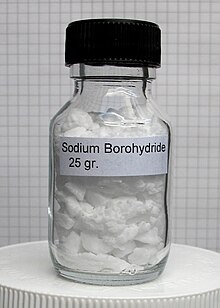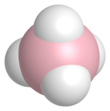
Back Natriumboorhidried Afrikaans بورهيدريد الصوديوم Arabic سودیوم تترا هیدروبورات AZB Tetrahydridoboritan sodný Czech Natriumborhydrid Danish Natriumborhydrid German Natria borohidrido Esperanto Borohidruro de sodio Spanish سدیم تترا هیدروبورات Persian Natriumboorihydridi Finnish

| |||

| |||
| |||
| Names | |||
|---|---|---|---|
| IUPAC name
Sodium tetrahydridoborate(1–)
| |||
| Systematic IUPAC name
Sodium boranuide | |||
| Identifiers | |||
| |||
3D model (JSmol)
|
|||
| ChEBI | |||
| ChemSpider | |||
| ECHA InfoCard | 100.037.262 | ||
| EC Number |
| ||
| 23167 | |||
| MeSH | Sodium+borohydride | ||
PubChem CID
|
|||
| RTECS number |
| ||
| UNII | |||
| UN number | 1426 | ||
CompTox Dashboard (EPA)
|
|||
| |||
| |||
| Properties | |||
| Na[BH4] | |||
| Molar mass | 37.83 g·mol−1 | ||
| Appearance | white crystals hygroscopic | ||
| Density | 1.07 g/cm3[1] | ||
| Melting point | 400 °C (752 °F; 673 K)(decomposes)[1] | ||
| 550 g/L[1] | |||
| Solubility | soluble in liquid ammonia, amines, pyridine | ||
| Structure[2] | |||
| Cubic (NaCl), cF8 | |||
| Fm3m, No. 225 | |||
a = 0.6157 nm
| |||
| Thermochemistry[3] | |||
Heat capacity (C)
|
86.8 J·mol−1·K−1 | ||
Std molar
entropy (S⦵298) |
101.3 J·mol−1·K−1 | ||
Std enthalpy of
formation (ΔfH⦵298) |
−188.6 kJ·mol−1 | ||
Gibbs free energy (ΔfG⦵)
|
−123.9 kJ·mol−1 | ||
| Hazards | |||
| GHS labelling:[4] | |||
   
| |||
| Danger | |||
| H260, H301, H314, H360F | |||
| P201, P231+P232, P280, P308+P313, P370+P378, P402+P404 | |||
| NFPA 704 (fire diamond) | |||
| Flash point | 70 °C (158 °F; 343 K) | ||
| ca. 220 °C (428 °F; 493 K) | |||
| Explosive limits | 3% | ||
| Lethal dose or concentration (LD, LC): | |||
LD50 (median dose)
|
160 mg/kg (Oral – Rat) 230 mg/kg (Dermal – Rabbit) | ||
| Related compounds | |||
Other anions
|
Sodium cyanoborohydride Sodium hydride Sodium borate Borax Sodium aluminum hydride | ||
Other cations
|
Lithium borohydride | ||
Related compounds
|
Lithium aluminium hydride Sodium triacetoxyborohydride | ||
Except where otherwise noted, data are given for materials in their standard state (at 25 °C [77 °F], 100 kPa).
| |||
Sodium borohydride, also known as sodium tetrahydridoborate and sodium tetrahydroborate,[5] is an inorganic compound with the formula NaBH4 (sometimes written as Na[BH4]). It is a white crystalline solid, usually encountered as an aqueous basic solution. Sodium borohydride is a reducing agent that finds application in papermaking and dye industries. It is also used as a reagent in organic synthesis.[6]
The compound was discovered in the 1940s by H. I. Schlesinger, who led a team seeking volatile uranium compounds.[7][8] Results of this wartime research were declassified and published in 1953.
- ^ a b c Haynes, William M., ed. (2011). CRC Handbook of Chemistry and Physics (92nd ed.). CRC Press. p. 4.89. ISBN 978-1439855119.
- ^ Ford, P. T. and Powell, H. M. (1954). "The unit cell of potassium borohydride, KBH4, at 90° K". Acta Crystallogr. 7 (8): 604–605. Bibcode:1954AcCry...7..604F. doi:10.1107/S0365110X54002034.
{{cite journal}}: CS1 maint: multiple names: authors list (link) - ^ CRC handbook of chemistry and physics : a ready-reference book of chemical and physical data. William M. Haynes, David R. Lide, Thomas J. Bruno (2016-2017, 97th ed.). Boca Raton, Florida. 2016. ISBN 978-1-4987-5428-6. OCLC 930681942.
{{cite book}}: CS1 maint: location missing publisher (link) CS1 maint: others (link) - ^ Record of Sodium borohydride in the GESTIS Substance Database of the Institute for Occupational Safety and Health, accessed on 2023-11-09.
- ^ Busch, D.H. (2009). Inorganic Syntheses. Vol. 20. Wiley. p. 137. ISBN 9780470132869. Retrieved 20 May 2015.
- ^ Banfi, Luca; Narisano, Enrica; Riva, Renata; Stiasni, Nikola; Hiersemann, Martin; Yamada, Tohru; Tsubo, Tatsuyuki (2014). "Sodium Borohydride". Encyclopedia of Reagents for Organic Synthesis. pp. 1–13. doi:10.1002/047084289X.rs052.pub3. ISBN 9780470842898.
- ^ Schlesinger, H. I.; Brown, H. C.; Abraham, B.; Bond, A. C.; Davidson, N.; Finholt, A. E.; Gilbreath, J. R.; Hoekstra, H.; Horvitz, L.; Hyde, E. K.; Katz, J. J.; Knight, J.; Lad, R. A.; Mayfield, D. L.; Rapp, L.; Ritter, D. M.; Schwartz, A. M.; Sheft, I.; Tuck, L. D.; Walker, A. O. (1953). "New developments in the chemistry of diborane and the borohydrides. General summary". J. Am. Chem. Soc. 75: 186–90. doi:10.1021/ja01097a049.
- ^ Hermann I Schlesinger and Herbert C Brown (1945) "Preparation of alkali metal compounds". US Patent 2461661. Granted on 1949-02-15; expired on 1966-02-15.
© MMXXIII Rich X Search. We shall prevail. All rights reserved. Rich X Search


